The holiday shopping season is coming, and with it comes some of the biggest opportunities to boost sales for ecommerce brands everywhere.
That’s not hyperbole—this period can account for up to 40% of a company’s annual sales. During the 2022 holiday season, there was a 7.38% conversion rate and 17.5% more shoppers for Shopify Plus merchants compared to 2021. The challenge? Holiday marketing is tough—almost every company does it, and standing out feels near impossible. Enter: 20 best holiday marketing campaigns that will inspire yours, help you reach a wider audience, and boost sales. Let’s dive in.
Table of Contents
- Frost Fair 1683: commerce meets Christmas
- Dickens 1843: the new (old) holidays
- Macy’s 1874: over a century of holiday innovation
- Coca-Cola 1923: go against tradition and iterate
- Sears 1933: the OG holiday gift guide
- NORAD 1955: inspiring Google years later
- Norelco 1960s: cutting-edge advertising (literally)
- M&M’s 1996: time to mash up the merry
- Starbucks 1997 to present: a yearly signal that holidays are here
- Office Depot (OfficeMax) 2006: turning 1.5 billion people into elves
- Old Spice 2011: MANta Claus is coming to town
- WestJet 2012 to present: bringing Christmas miracles to life
- LEGO 2012: resurrecting a brand with holiplay
- Christmas 24 2015: presents for strangers in Birmingham
- Amazon 2017: give a little bit (or a lot)
- Pourri 2017: you’re doing the holidays wrong
- Spotify 2017: building #2018Goals from customer data
- Dogs Trust 2018: the ’what if’ strategy
- Hafod Hardware 2019: big values don’t need a big budget
- Peloton 2021: a new spin on an old story
1. Frost Fair 1683: commerce meets Christmas
Until the late 1600s, Christmas was a somber affair for those who celebrated. But when a series of freak ice storms hit London in 1683 and 1684, they provided just the excuse people needed to go a bit wild.
The River Thames froze and became the ground for the Frost Fair—a mix of seasonal celebration and pop-up commerce. One researcher described it as London’s most debaucherous party, “where the main trade was booze and the principal activity was having as wild a time as possible without breaking the ice.”

“Frost Fair on the River Thames, 1684,” a drawing by an unknown artist from around the year 1800. Source
Based on the time of year and its mix of merchants and merriment, Frost Fair became a cultural hinge in the development of Christmas in the West.
The lesson is one that savvy online-to-offline businesses know well: It’s nice when customers come to you. It’s better when you go to them. But it’s best when the whole thing comes off as one big party.
That lesson is still true today.
Take Gymshark, a fitness apparel powerhouse with a annual revenue of $600 million. Much of that success comes from the pop-ups it runs like full-scale events: one part shopping, one part influencer rock concerts, and all parts experiential.
2. Dickens 1843: the new (old) holidays
There was a day, as Time magazine recently noted, when Christmas was “a decidedly second-rate holiday in Great Britain, compared even to Boxing Day.”
In America, Christmas was outlawed in many states throughout the 18th century. It originated in the US as a pagan festival more akin to Halloween, causing Puritans in the 18th and 19th centuries to crack down on the holiday, in response to the Frost Fair–type of revelry mentioned above.
Then, in December 1843, Charles Dickens changed everything.
The massive and unforeseen success of his book A Christmas Carol reshaped the holiday along jovial lines and made it about friends, family, and—of course—presents.
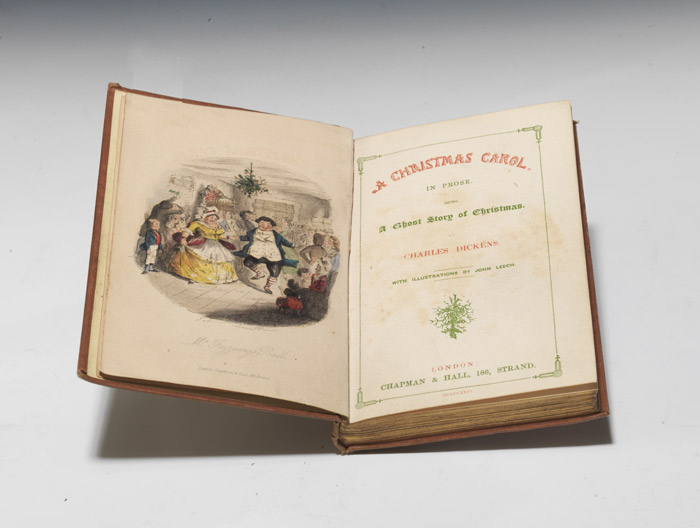
Charles Dickens’ A Christmas Carol. Source
Naturally, A Christmas Carol wasn’t so much a holiday campaign as it was a runaway success in and of itself. Still, its success contains a critical lesson we’ll see show up over and over in many of the campaigns below.
Better than discounts, better than sales, better than advertising itself—stories sell.
3. Macy’s 1874: over a century of holiday innovation
Window displays don’t exactly sound innovative.
But during the late 1800s—when plated glass first became widely available—owners and managers who built large windows running the length of their stores were at the cutting edge of holiday marketing.
In fact, Macy’s in New York City was America’s first department store to decorate its windows for Christmas, in 1874. It showcased holiday stories for all to watch: the window featured porcelain dolls and recreated scenes from Harriet Beecher Stowe’s Uncle Tom’s Cabin.

Macy’s window display that attracted thousands of viewers in the early 1900s. Source
For more than 25 years, Macy’s was one of the only major retailers to create window displays—making it an attraction for local New Yorkers and tourists alike. Thanks to Macy’s success, the holiday window display competition became fierce in New York City, Chicago, and Philadelphia.
You can stand out with your Christmas window display, or an online holiday marketing campaign, by putting your own spin on the usual holiday themes.
4. Coca-Cola 1923: go against tradition and iterate
Jolly old Saint Nick didn’t always look jolly. In the original imagery artists created in the 19th and early 20th centuries, Santa was tall and slender, scary, and quite strict-looking.
Enter the Coca-Cola Company.
In 1923, it commissioned an artist to create a likeness of Santa for a print ad—one of the oldest holiday advertisement examples we could find.
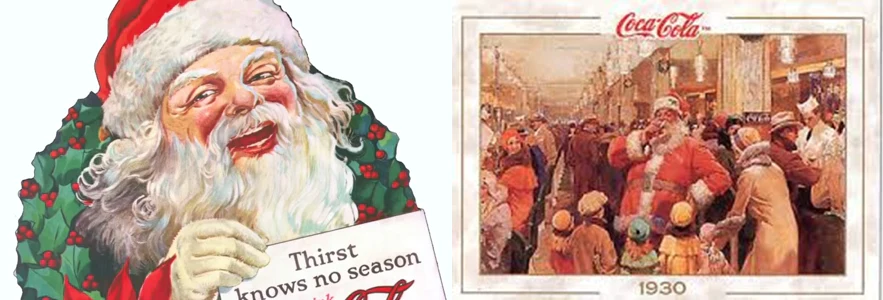
Original Coca-Cola Santa circa 1923 (left); Fred Mizen’s 1930 Coca-Cola Santa in the crowd (right)
The first two iterations were less than popular. These Santas didn’t make anyone feel warm and fuzzy for the holidays.
In 1931, Coca-Cola began placing ads in popular magazines. It wanted to feature a more wholesome Santa, one that was both realistic and symbolic. The company commissioned Haddon Sundblom, an illustrator from Michigan, to achieve exactly that.
Sundblom successfully brought a new Santa to life, making him the fun-loving, jolly, rounded belly, ho-ho-ho Santa we all know and love today.
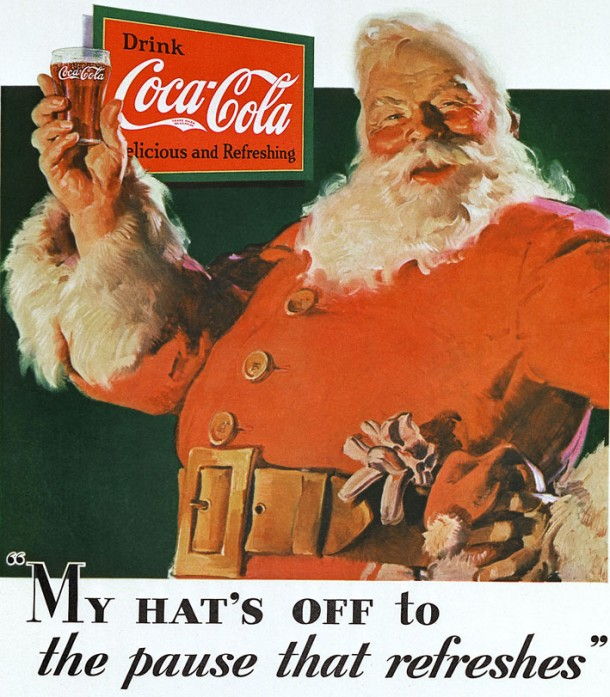
Sundblom’s first Coca-Cola Santa from 1931. Source
Because Coca-Cola’s campaign took place during the Great Depression, canvas and paint were considered luxury items—so Sundblom painted over the first Santa (from 1923) to create the new one. Sundblom would later illustrate all Coca-Cola Santa ads from 1931 through 1964.
It’s always risky to go against tradition. But remember: Coca-Cola iterated for nearly a decade before their Santa became the new standard.
When your brand goes big, expect the same success.
5. Sears 1933: the OG holiday gift guide
Long before social media, the internet, or TV advertising, there was the Sears Wish Book.
For more than 80 years, Sears ruled over the holiday dreams of children and parents alike through an annual piece of direct-mail brilliance. Its first Wish Book—then named the Sears Christmas Book catalog—came out in 1933.
The Wish Book included everything from the “Miss Pigtails” doll and an electric train set to fruitcakes, a five-pound box of chocolates, and live singing canaries. And as tastes, styles, and trends evolved, so did the Wish Book, making it a staple of holiday list-making.
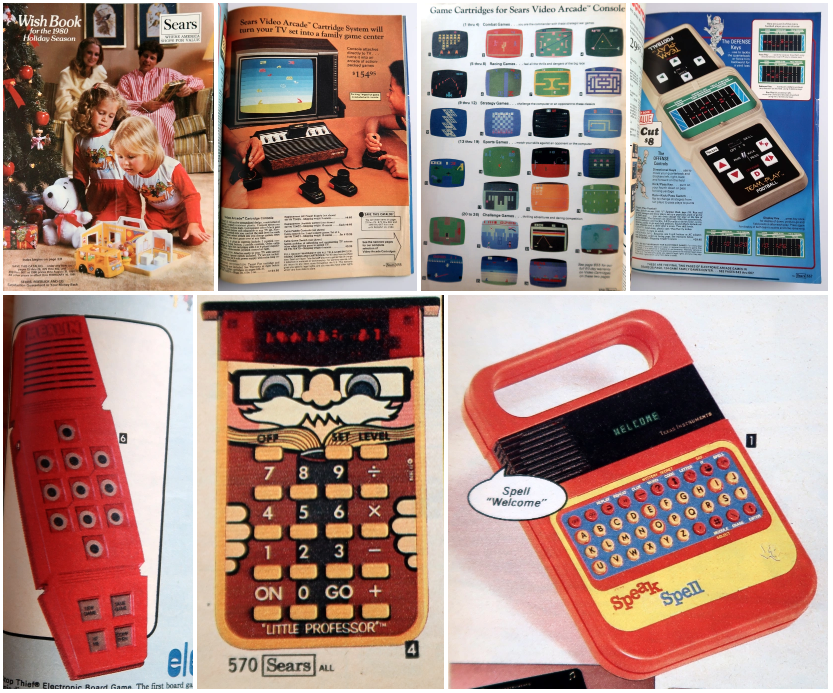
Photos from the 1980 edition of the Sears Wish Book. Source
While the Wish Book saw its final printing in 2017, holiday gift guides and online lookbooks are still holiday campaign magic. They can be a lucrative source of organic traffic, both through search engines and social media posts—think Pinterest boards and saveable images on Instagram.
Gift guides also work well as promoted content through native advertising platforms, as well as sponsored or branded content on mainstream publishers.

Examples of branded content on The New York Times, which sets the gold standard in branded content
6. NORAD 1955: inspiring Google years later
Google may have digitized Santa Claus tracking, but it certainly didn’t invent it. That honor belongs to NORAD—the North American Aerospace Defense Command.
In a happy coincidence, in 1955, Sears put a holiday ad in a Colorado Springs newspaper for kids to phone Santa. But a one-digit misprint led curious and excited children to reach CONAD, the Continental Air Defense Command (and NORAD’s predecessor) instead.
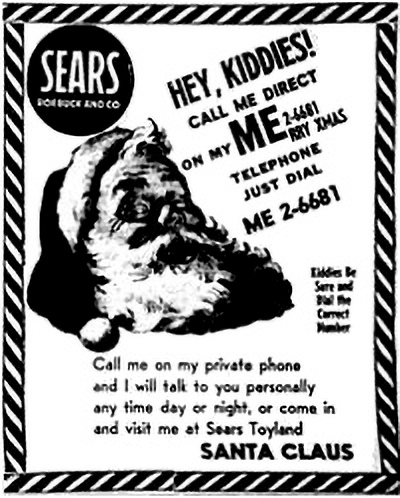
A 1955 Sears ad inviting children to call Santa on his phone. Source
Not wanting to crush children’s dreams, CONAD played along and reported Santa’s location to their young callers. And that’s how a top-security-level federal government agency in America became the tracker of sleighs and flying reindeer.
Fast forward more than 50 years, when Google decided it could do better. It used the Keyhole EarthViewer, the original name for Google Earth, to create the Santa Tracker. Google improves it every year with more games and interactive experiences for children of all ages.
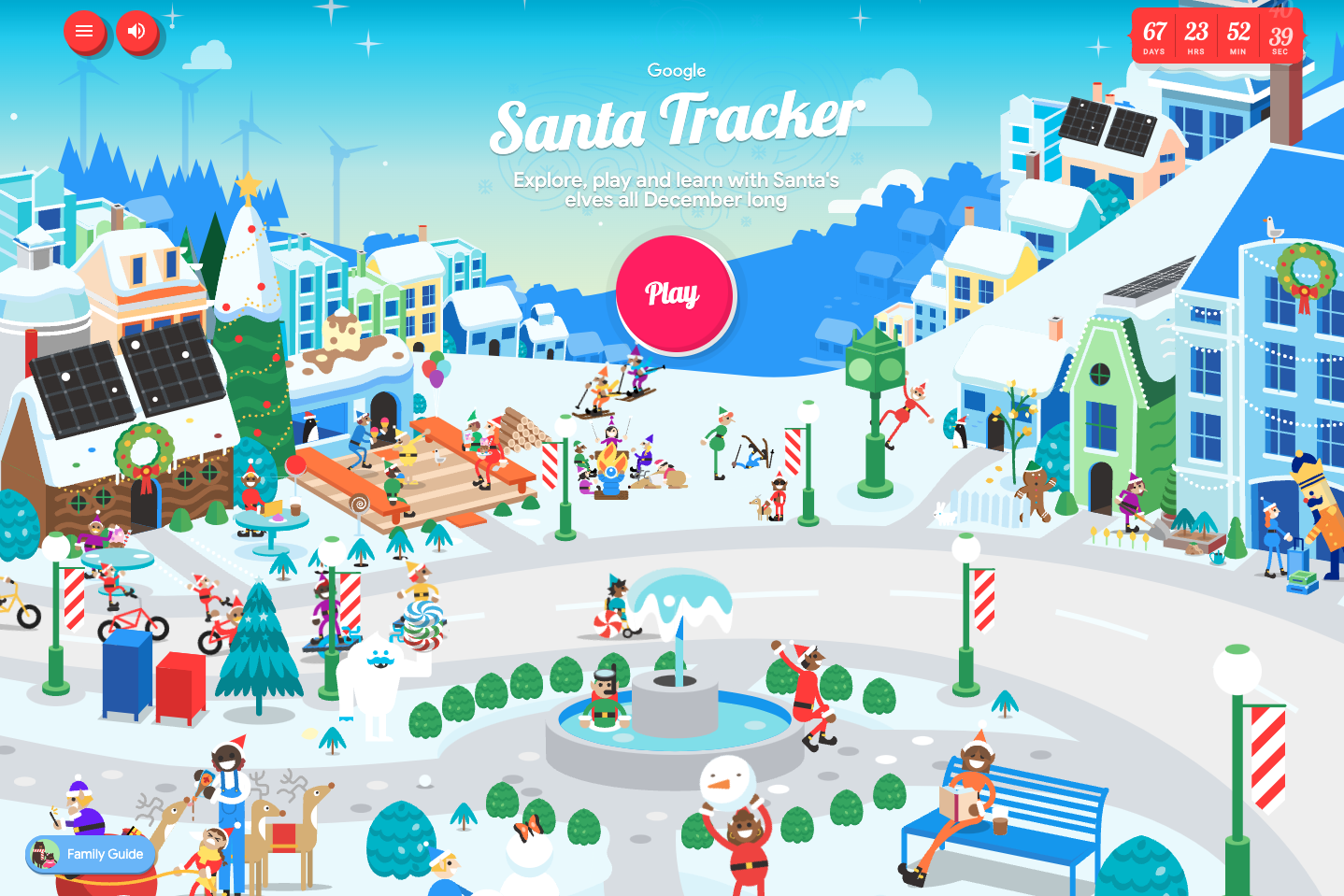
Google’s Santa Tracker. Source
The lesson: Google took an incredible idea (tracking Santa Claus) and used its intelligence (Google Earth images) to bring it to life.
7. Norelco 1960s: cutting-edge advertising (literally)
In 1964, NBC and Rankin/Bass Productions broke new ground by airing the first stop-motion animated holiday film: Rudolph the Red-Nosed Reindeer. It instantly became a modern classic.
What you might not know is that Norelco—a Philips brand of electric shavers since 1939—was the first to use this emerging technology for a holiday retail campaign.
On the heels (or rather, the hooves) of Rudolph came Santa, riding a host of Norelco products.
In the commercial, you can hear clever lines like “Christmas is a time for closeness, and closeness is what Norelco razors are all about,” as well as “Norelco: Even our name says Merry Christmas.”
During that last line, the word Nöelco shows up on the screen (Nöel is French for Christmas).
Throughout the late 1960s and into the 1980s, Norelco improved upon the quality of production. People loved it back then and still remember it fondly. The company created an ad in this style again in 2011, but the modern production didn’t land—the sparkle had worn off.
What’s the lesson?
Much like Macy’s window displays, Norelco moved fast to integrate the latest tech into its holiday ads—and it paid off for a couple of decades.
8. M&M’s 1996: time to mash up the merry
You know those M&M’s characters that have legs, arms, and the ability to speak? They’re known as M&M’s spokescandies, the company’s mascots that started appearing in its ads back in 1954.
Parent company Mars’ take on a holiday marketing campaign for its M&M’s brand is the 15-second TV commercial called Faint, released in 1996. In it, two spokescandies are preparing M&M’s candies for Santa, wondering if he’d like red and green ones.
But as they walk into the living room to finish their quest, it turns out that Santa has already arrived—and both Santa and one of the spokescandies faint.
This holiday ad campaign is so iconic that it has returned to TV screens every year since 1996.
If your ecommerce brand has its own mascot, like an animal or a fictional character, consider creating a story in which it interacts with a well-known holiday character.
9. Starbucks 1997 to present: a yearly signal that holidays are here
Starbucks is everywhere—seriously. Almost wherever you are in the world, you’ll come across a Starbucks.
The brand’s trademark “product” is the cup in which actual products end up in customers’ hands. During the year, the Starbucks cup is white and features the recognizable green Starbucks logo.
In 1997, Starbucks released its first holiday-themed cup in place of their plain white one. The first version was purple, but within a couple of years, the now well-known Starbucks holiday cup became recognizably red.

Different versions of Starbucks holiday cups over the years. Source
As years passed, Starbucks’ holiday cups became a symbol of the winter season. They’re now part of popular culture, and “the appearance of the red cup signals to people that it’s time to celebrate the holidays,” explains Sandy Nelson, Starbucks’ former senior graphic designer.
People excitedly wait to see what Starbucks has come up with each year—so much so that someone designed a Countdown to Red Cups website. This holiday campaign drives user-generated content and media coverage and boosts Starbucks’ reach every holiday season.
10. Office Depot (OfficeMax) 2006: turning 1.5 billion people into elves
Standing out in the busy holiday shopping season is tough. So the execs at Office Depot hired a creative agency to develop 20 holiday-themed websites in lieu of traditional 30-second TV ads.
That’s what led to OfficeMax (an Office Depot brand) launching Elf Yourself, a website where users can turn themselves into an elf in a saveable photo. In 2006, the site was getting more than 200 hits per second and got featured in the biggest TV shows and media sites in the US. In 2008, Elf Yourself got over 400 million visits and 40 million media impressions.
As of 2017, 1.5 billion elves have been created with Elf Yourself.

Promo image of the Elf Yourself app. Source
Year after year, the campaign went viral, giving OfficeMax more reach than any short TV ad probably could.
Its success proves that you don’t have to spend exorbitant amounts of money on retail advertising, especially during the heavily competitive holidays. With digital, you can use the web to do the heavy lifting at a fraction of the price—and, often, with greater and quicker results.
11. Old Spice 2011: MANta Claus is coming to town
“The Man Your Man Could Smell Like” is a viral marketing campaign from 2010 that brought Old Spice droves of commercial success and awards. In it, actor Isaiah Mustafa talks in hyperbole and an over-the-top manner to female viewers asking them to compare him, a stereotypically strong, muscular man, to their partner. It’s what made the campaign hilarious.
The brand brought Isaiah Mustafa back for the 2011 holiday season in a series of videos called MANta Claus. This time, Mustafa goes on a quest to “give a gift to every single person on Earth this holiday season.”
In each video of this holiday ad campaign, he addresses a group of people or a specific person and shows the gift he prepared for them. Old Spice took its familiar theme of being ridiculous and kicked it up a notch for the holidays.
Year-round consistency—being on-brand, in season and off—is what makes this a great holiday marketing campaign.
Chubbies, a Shopify Plus apparel merchant, also excels at this approach with its Thighber Monday campaigns on YouTube and social media. On top of launching hilarious, captivating videos each year, Chubbies partners with influencers and promotes campaign-specific pages on its website.
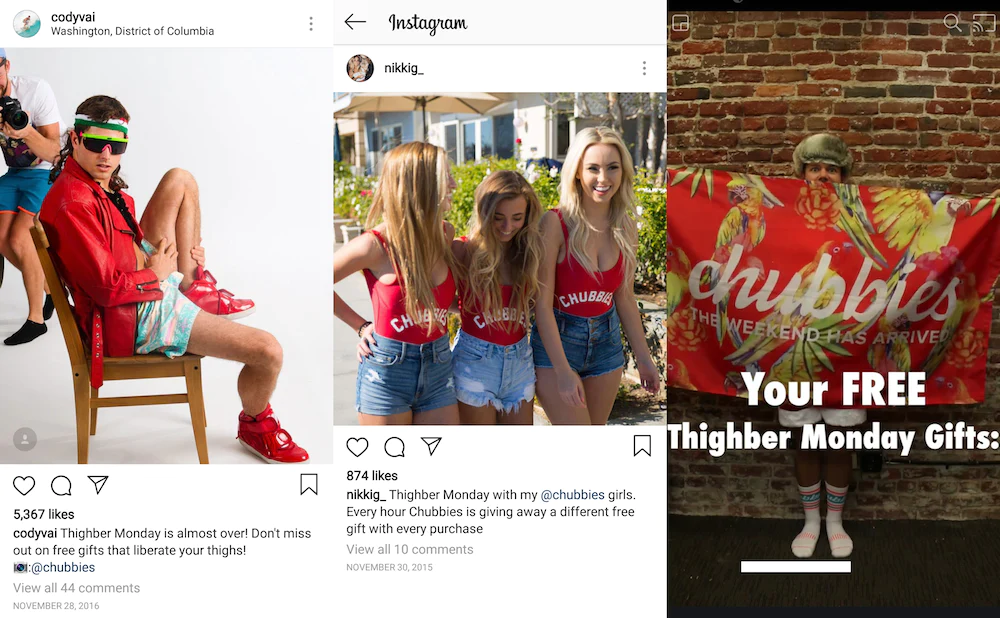
Chubbies’ Thighber Monday campaign on Instagram and its website.
12. WestJet 2012 to present: bringing Christmas miracles to life
The Canadian airline WestJet wanted to do something different for its customers on Christmas Eve in 2012. It surprised everyone at the Calgary airport (the airline’s hub) with a flash mob of carolers, dancing elves, and a blue-and-white Santa—Westjet’s brand colors—to brighten up everyone’s pre-boarding night.
The following year, WestJet upped its Christmas game with the WestJet Christmas Miracle campaign, which it’s been refining every year since.
The 2016 Christmas Miracle hit a little closer to home for Canadians. That summer, Fort McMurray—a town in Northern Alberta—was hit with a devastating forest fire that forced a city-wide evacuation. Support came pouring in from across the country and around the world as residents lost everything and were forced to start over. We dare you to not shed a tear while watching:
The moral of this holiday marketing story? The holidays are a time for doing good and hitting people in the feelers.
Your campaign may garner holiday sales, but if you’re trying to make something brand-defining, put everything you’ve got behind it.
Part two of the WestJet lesson is that, with the huge success of their initial campaign, they were able to rebrand an old classic—a Christmas miracle—and recreate a similar experience year after year.
This also means the team at WestJet is able to utilize this framework and customize the marketing experience based on circumstances and a particular need each year.
13. LEGO 2012: resurrecting a brand with holiplay
LEGO had a near-death experience in 2003 when it was reportedly $800 million in debt.
This isn’t about that story. This is about how innovation has repeatedly helped the company stand out—and even resurrect it.
LEGO wanted to bring its bricks to life (before The Lego Movie existed) and be a part of the real world. It created Happy Holiplay, a website featuring videos with instructions on building holiday staples like a Santa face, snowmen, and elves. Children were then encouraged to take photos of what they created in the real world and upload them to the site as part of a contest.
LEGO called this mix of LEGO bricks and the real world the Brickmented Reality.
User-generated content came from 119 countries and received more than 150,000 views over three weeks.
By creating an emotional bond between people and its product, this advertising example brought everyone back to their love of LEGO.
The lesson: You’re never too old to enjoy toys and games—and reminding people of an emotional connection will help build excitement and restore your brand values.
14. Christmas 24 2015: presents for strangers in Birmingham
Christmas 24 is a TV channel in the UK that plays back-to-back festive movies during the Christmas season (it’s called Movies 24 for the rest of the year).
In this campaign, it chose to show the importance of giving. Christmas 24 set up a larger-than-life present in the middle of Birmingham New Street, the largest and busiest subway station in Birmingham, UK, with a magic telephone.
Those who picked up the phone got to talk to Santa, who offered free presents to them. But as presents dropped, he said, “Presents are for giving, not for receiving,” and encouraged the person to take the wrapped gift and bring it to a specific person at the station.
The ultimate gift recipient, of course, is completely unaware of what’s about to happen. As they open the presents (like a Nespresso coffee machine, or a plush toy), joy and laughter follow.
Christmas 24 is all about getting folks excited about the holidays—and this activation in a busy subway station did exactly that. The campaign married the brand’s core values of celebrating the holidays and helping each other, and brings them to life for everyone in an unexpected way.
15. Amazon 2017: give a little bit (or a lot)
The holidays are a time to give. Give joy. Give love—and, of course, give presents. And Amazon, the ecommerce giant, wanted to remind everyone of the importance of giving.
What works in this iconic 2017 commercial is the use of Amazon’s smile logo that all Amazon packages feature. In the commercial, as warehouse staff prepare packages full of Christmas presents, the smile logos on the boxes sing the song Give A Little Bit (originally by Supertramp).
Highlighting the shipping process for a company like Amazon works because its brand is essentially about ecommerce for everyone. Remind your audience that this is the time of year to make everyone feel special, no matter how small the gesture.
To build on the giving theme, Amazon also organized a #DeliveringSmiles campaign that same year. The campaign featured a holiday tour with 30 stops across the US and Canada. Amazon donated $1 for each mile its trucks and people traveled on this tour, as well as thousands of items to families, children, and women to help them fight homelessness.
16. Pourri 2017: you’re doing the holidays wrong
Every carbon-based life-form has one thing in common: we poop. And humans also share the common holiday stress of “What do I get Karen from accounting for Secret Santa?” Shopify Plus merchant Pourri (formerly PooPourri) takes care of any distress associated with either process.
Holiday gift-giving is challenging, to say the least. Pourri went with a funny—and on-brand—ad featuring comedian JP Sears, known for his satirical humor, to address the challenge—and it works perfectly. Watch:
The holiday marketing takeaway is to use common holiday-season struggles to unite your customers. Even if your brand isn’t this funny, making light of stressful times is a great way to bring a little levity to your products during the holidays.
17. Spotify 2017: building #2018Goals from customer data
The digital music giant Spotify used its data intelligence to create a hilarious, engaging out-of-home (OOH) campaign in 2017.
Spotify took the names of playlists and habits of its customers to show the fun side of the brand—and probably even invite more creative playlist names.
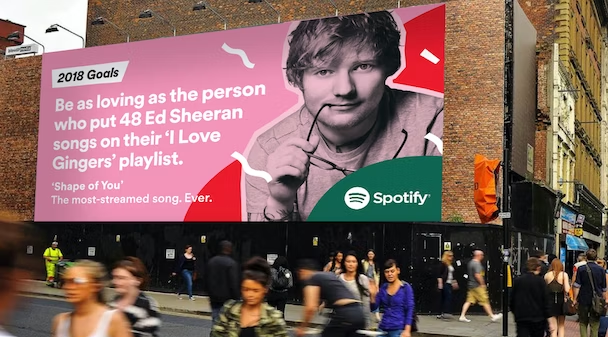
A Spotify billboard featuring Ed Sheeran. Source
The Spotify #2018Goals campaign reached a worldwide audience. It followed a similar concept Spotify used the year prior in its Thanks 2016, It’s Been Weird campaign, which pulled user stats to write “Dear person” billboards and ask poignant questions or make statements.
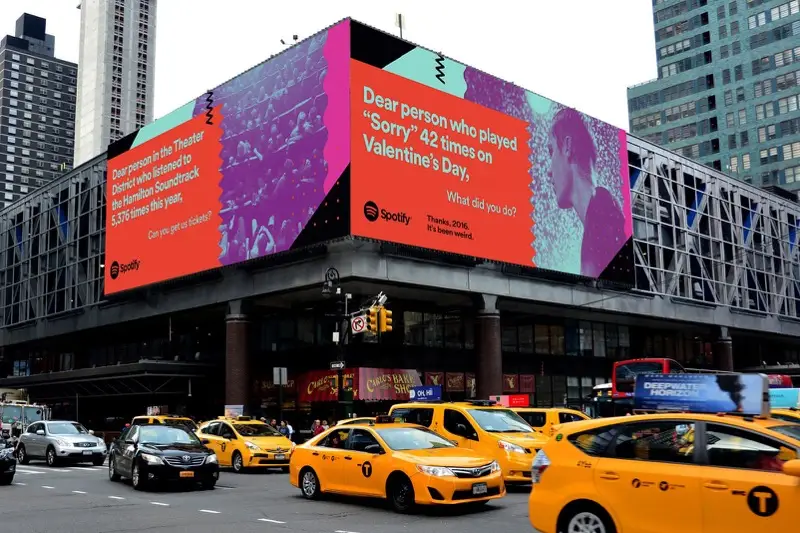
Spotify’s “Dear person” billboards in 2016. Source
The lesson to take from Spotify’s awesome campaigns is to use your customer data for good. If you have some interesting and fun insights like Spotify does, sharing them is a unique way to get engagement.
18. Dogs Trust 2018: the ‘what if’ strategy
After Christmas in 2017, Dogs Trust—a dog rehoming and rescue charity—received nearly 5,000 calls from people wanting to hand over their dog.
This crisis is what its 2018 campaign wanted to prevent. Dogs Trust wanted to send a message that dogs are for life, not just for Christmas—and it wanted to make sure the ad stood out in the busy holiday marketing season.
The ad they launched hit the perfect spot. It shows a sequence of ridiculous scenes in which people try to walk a gaming console, play fetch with a hairdryer, play tricks with a drone, and say goodnight to a bottle of perfume.
The video ends with the message that Christmas presents aren’t dogs, and dogs aren’t Christmas presents.
Nice and Serious, the agency that worked with Dogs Trust on this campaign, wanted to avoid both a sad tone and an overly celebratory one that would encourage people to buy dogs as gifts. Luckily, the team landed on an idea that worked.
“It’s just ridiculous to think about treating an animal as a present—wrapping it up would be madness. So what if we showed people treating their regular Christmas presents like dogs?” Peter Larkin, the creative director at Nice and Serious, told Fast Company.
For your own holiday marketing campaign, try asking and answering some “what if” questions, just like the team at Nice and Serious did. You may end up with a hit, just like they did.
19. Hafod Hardware 2019: big values don’t need a big budget
If any of the above holiday marketing campaigns made you think that you need a huge budget and a large production team to reach your audience, Hafor Hardware will give you a different perspective.
Check out its 2019 Christmas marketing campaign: it features a two-year-old that gets ready for work, opens the hardware shop, cleans the floor, serves customers, wraps gifts, and does some accounting. At the end of his workday, he locks the store and bends down to pick up a Christmas tree.
Then comes the plot twist: he’s actually a 30-year-old man. Finally, the message “Be a kid this Christmas” appears.
The kicker? Hafod Hardware is a small, independent, family-run hardware store in Wales, and this family spent only £100 (around $120) to create this two-minute advert.
The ad reached over 2.5 million viewers and reinforced Haford Hardware’s values: family, community, and the strength and importance of independent businesses. Instead of feeling discouraged by big brands with big budgets, take a lesson from Hafod Hardware to show what you’re about through simple, but impactful storytelling.
20. Peloton 2021: a new spin on an old story
In this holiday ad example, Peloton decided to retell Charles Dickens’ A Christmas Carol almost 180 years later.
As you’d expect, Scrooge screams at Christmas carolers and shuts the door in their faces in Peloton’s version, too. But then, he returns inside to a gift—a brand new Peloton bike. Once he jumps on it, everything changes.
“The gift of the Peloton bike did touch his soul—riding fast, flowing proud, getting hella swole,” the voiceover explains. It made Scrooge a completely different man.
The ad ends with an iconic “When your workout is a joy, it’s a joy to work out” message. Peloton tied the grumpiness that often comes with the idea of working out with the one Scrooge is known for—and turned a centuries-old story into a modern one.
This ad shows just how well Peloton knows its target audience and the challenges they experience on their journey to an active life. To replicate this for your business, find what that challenge is for your ideal customers, and connect it to a well-known Christmas character or story.
’Tis the season for holiday marketing campaigns to bring the magic
When it’s all said and done, how do you want holiday shoppers to remember you this holiday season?
What these brands all showed is that holiday marketing can make a real mark long after the festive period is over. It’s the time of the year that rewards innovative and stand-out campaigns.
Don’t be afraid to think big: Take a step outside of the traditional Christmas present box. Go beyond your usual campaign parameters and hit your audience in their feelers—happiness, empathy, laughter—if you want to hit your own holiday marketing goals.
Holiday campaigns FAQ
Why are holiday campaigns important?
The end-of-year holiday season is the busiest shopping season. Many companies earn as much as 40% of their annual revenue during this time. As customers look for the best prices and ideal gifts, running a holiday campaign can help you grow your brand awareness and boost sales.
What are the best holidays to advertise?
The Black Friday Cyber Monday (BFCM) weekend takes the top spot in online sales. In 2022, online shoppers in the US spent a record $9.12 billion on Black Friday. It’s worth launching holiday campaigns before that weekend to make the most of the engagement throughout BFCM weekend up to the new year.
How do you attract customers on holidays?
You can attract and engage holiday shoppers with tactics like detailed gift guides, custom discounts, holiday videos, and gift bundles. Key elements of successful holiday sales also include easy returns, fast shipping, and flexible shopping options like buy online, pickup in-store (BOPIS).
Read More
- The Seven Signs Your Supply Chain Is Hemorrhaging Money & How to Fix It
- Selling $3 Billion on Autopilot: Less Effort, More Growth via Ecommerce Automation
- How to Use a What-if Analysis to Measure the Effects of Your Decisions
- Multi-Channel Customer Acquisition: 7 Tips from $3.7M+ in Ad Spend
- 17 User-Generated Content Examples and 5 Tactics to Grow $15M+ in Annual Sales
- Hypefest 2018: O2O Examples from the Forefront of Marketing & Retail
- Ecommerce Usability 101: Are You Making it Difficult For Visitors to Purchase?
- Ecommerce Navigation: Getting People to Find and Buy More Products
- Is Your Agency 'The One'? An Inside Scoop on Finding a True Partnership
- Email Popups With Offer Codes Are The Best & Other Ecommerce Optimization Myths






